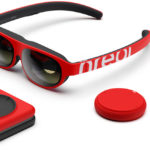This is the review of the Nreal Light Development Kit which can be ordered from the Nreal website for $1199. For this review, I had to made a decision: should I concentrate on the development side or should I more look at the device from a consumer’s standpoint. I decided for the latter because I believe that only if the device is exciting for consumers it would be worth it for developers to pick up this development kit.
And consumers do have reasons to look forward to this device. I believe the Nreal Light will be the first AR headset that consumers truly will want to buy once it hits the market for $500. One of the reasons is the great picture quality which is way better than that of the $3500 HoloLens 2. Now let that sink in for a moment. Yes, the picture quality of the $500 Nreal Light is better than that of the $3500 HoloLens 2!
Now how is that possible? That’s also what I was wondering. Actually, the Nreal Light is not trying to reinvent the wheel when it comes to the display technolgy. Two 1080p micro Oled displays project a picture downwards from above the top of the frame that gets reflected from the lenses of the glasses into the user’s eye. Nothing spectacular, but it just works! For the HoloLens 2, lasers get reflected from a mirror onto a glass panel that will make it visible for users. That sounds more fancy, but unfortunately the result looks worse and the displays of the HoloLens 2 suffers from what I would call a “rainbow effect”. Check out the video review to see how that actually looks like.
Colors look beautiful and the picture looks incredibly crisp. There is no SDE and when watching a movie the picture looks better than in any of the VR headsets that I have tested unitl now.
It is surprising how intensive the picture is, even though I was in a brightly lit room. You could hardly see behind the bright parts of the picture and that is quite astounding. I could see myself watch a whole movie with those glasses while in an airplane or a train. It is just like watching a movie on a TV set. I might even prefer this over watching a movie in the Oculus Quest while traveling because the headset simply looks more “normal” and I could still receive my food in a plane while wearing these.
From the few demos that I found on the devkit I can tell that tracking also works well. The headset sports two cameras that are responsible for tracking its position in the world. Virtual objects stay in their real world position and you can walk around them without any problems. You can also leave the room, come back and they are still where they are supposed to be. Of course I will need to test more apps to really give a final opinion about tracking and for these demos there was also absolutely no hand-tracking yet, but from what I saw the tracking looked solid.
With 52° the FOV of the Nreal Light exactly matches the FOV of the HoloLens 2. Of course that is way less than what VR headsets offer but you have to keep in mind that you can still see the real world in your peripheral vision. Also the frames of the Nreal Light will limit your FOV anyways. In the demos I checked out the FOV was not limiting me all too much, but of course when I came closer to the virtual objects, they would be cut at the FOV border which would make the constraints quite obvious. However, if the objects where observed from a certain distance, the illusion of those objects appearing in your real world is very convincing.
The devkit comes with a compute unit, an Android smartphone without a screen that supplies the headset with energy and content. The device sports a Snapdragon 845 but when consumers pick up the headset later this year they will need an Android phone with at least a Snapdragon 855, no iPhone support has been announced yet.
When the glasses debut for consumers they will be able to use their Android apps with the glasses. They would float as huge virtual screens in front of the user and several apps could be opened in that fashion at the same time. Imagine watching YouTube videos on your main screen while having your Twitter feed floating on the right and your latest WhatsApp messages on the left. This is a really attractive use case and all of that will be controlled via the user’s smartphone that becomes a 3DOF pointing device with the touchscreen as input method. The compute unit also offers this functionality via a little controller disc that is connected to the compute unit via magnet. It works as expected but after having used 6DOF controllers for years now 3DOF controllers simply cannot excite anyone anymore. It works and it makes sense for now but hopefully the company will offer a complete hand tracked solution in the future.
Overall I am impressed with the Nreal Light and since I believe that consumers will indeed be excited about these AR glasses I would recommend this kit to developers who would like to get a head start for their apps in the upcoming AR app ecosystem.

